Appendix 3. Guidelines to Prevent Central Line-Associated Blood Stream Infections
Tools for Reducing Central Line-Associated Blood Stream Infections
Contents
Slide 1. Guidelines to Prevent Central Line-Associated Blood Stream Infections
Slide 2. Why do I need to complete this orientation?
Slide 3. Why do I need to complete this orientation? (cont.)
Slide 4. Statistics for CLABSIs
Slide 5. National Nosocomial Infection Surveillance Rates
Slide 6. CLABSI Rates per 1,000 Catheter Days
Slide 7. Risk Factors for CLABSI
Slide 8. Risk Factors for CLABSI (cont.)
Slide 9. Process of Catheter-Related Infections
Slide 10. Five Evidence-Based Steps to Prevent CLABSI
Slide 11. Hand Hygiene
Slide 12. Hand Hygiene Works!
Slide 13. Waterless Hand Hygiene Steps
Slide 14. Hand Washing Steps
Slide 15. C-VAD Site Selection
Slide 16. C-VAD Site Selection: Special Considerations
Slide 17. C-VAD Line Selection
Slide 18. Aseptic Technique: Goals
Slide 19. Aseptic Technique
Slide 20. Evidence Supporting Chlorhexidine Use: Skin Prep—Meta Analysis
Slide 21. Maximal Barriers Required for C-VAD Insertion
Slide 22. Maximal Barrier Precautions Decrease CLABSI Infections
Slide 23. Caveats: Catheter Insertion
Slide 24. Post Insertion: C-VAD Care
Slide 25. Replacing C-VADs
Slide 26. Suspected C-VAD Infections
Slide 27. Suspected C-VAD Infections (cont.)
Slide 28. C-VAD Line Cultures: Indications
Slide 29. C-VAD Line Cultures: Method
Slide 30. C-VAD Line Cultures: Interpretation
Slide 31. Blood Cultures
Slide 32. Peripheral Blood Cultures: Method
Slide 33. Arterial Line: Site Selection
Slide 34. Arterial Lines: Aseptic Technique
Slide 35. Arterial Lines: Barriers
Slide 36. Special Thanks
Slide 1. Guidelines to Prevent Central Line-Associated Blood Stream Infections
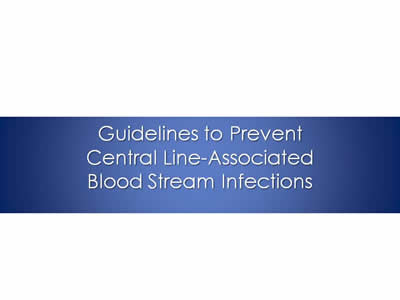
Guidelines to Prevent Central Line-Associated Blood Stream Infections
Slide 2. Why Do I Need to Complete This Orientation?
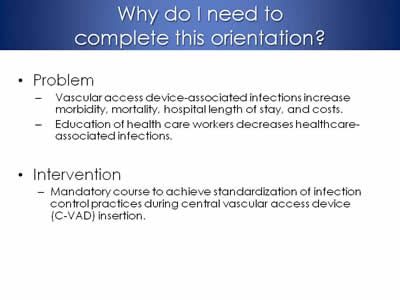
- Problem:
- Vascular access device-associated infections increase morbidity, mortality, hospital length of stay, and costs.
- Education of health care workers decreases healthcare-associated infections.
- Intervention
- Mandatory course to achieve standardization of infection control practices during central vascular access device (C-VAD) insertion.
Slide 3. Why Do I Need to Complete This Orientation? (cont.)

- Outcome:
- Education in another center achieved a 28 percent relative reduction in central line infections and saved $800,000.*
- Since implementing this orientation, that center's central line-associated related blood stream infection (CLABSI) rates have decreased below the national average.
* Sherertz, et al. Ann Intern Med. 2000;132(8):641-648
Slide 4. Statistics for CLABSIs
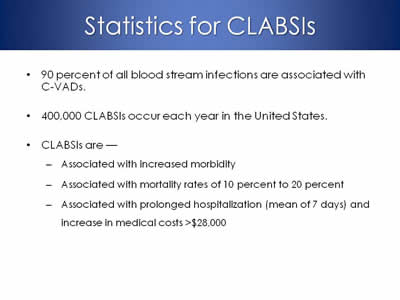
- 90 percent of all blood stream infections are associated with C-VADs.
- 400,000 CLABSIs occur each year in the United States.
- CLABSIs are:
- Associated with increased morbidity
- Associated with mortality rates of 10 percent to 20 percent
- Associated with prolonged hospitalization (mean of 7 days) and increase in medical costs >$28,000
Slide 5. National Nosocomial Infection Surveillance Rates
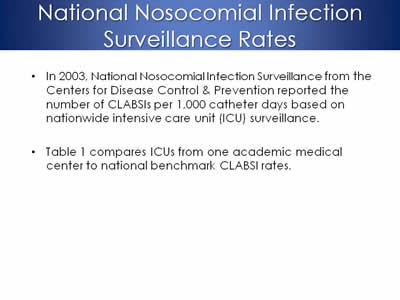
- In 2003, National Nosocomial Infection Surveillance from the Centers for Disease Control & Prevention reported the number of CLABSIs per 1,000 catheter days based on nationwide intensive care unit (ICU) surveillance.
- Table 1 compares ICUs from one academic medical center to national benchmark CLABSI rates.
Slide 6. CLABSI Rates per 1,000 Catheter Days
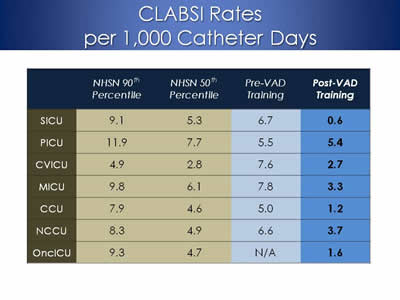
| NHSN 90th Percentile |
NHSN 60th Percentile |
Pre-VAD Training |
Post-VAD Training |
|
|---|---|---|---|---|
| SICU | 9.1 | 5.3 | 6.7 | 0.6 |
| PICU | 11.9 | 7.7 | 5.5 | 5.4 |
| CVICU | 4.9 | 2.8 | 7.6 | 2.7 |
| MICU | 9.8 | 6.1 | 7.8 | 3.3 |
| CCU | 7.9 | 4.6 | 5.0 | 1.2 |
| NCCU | 8.3 | 4.9 | 6.6 | 3.7 |
| OncICU | 9.3 | 4.7 | N/A | 1.6 |
Slide 7. Risk Factors for CLABSI
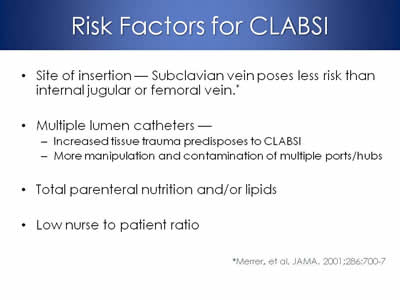
- Site of insertion — Subclavian vein poses less risk than internal jugular or femoral vein.*
- Multiple lumen catheters:
- Increased tissue trauma predisposes to CLABSI
- More manipulation and contamination of multiple ports/hubs
- Total parenteral nutrition and/or lipids
- Low nurse to patient ratio
* Merrer, et al. JAMA. 2001;286:700-7
Slide 8. Risk Factors for CLABSI (cont.)
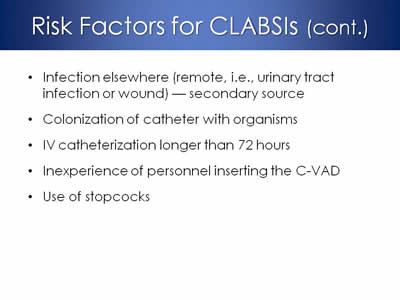
- Infection elsewhere (remote, i.e., urinary tract infection or wound) — secondary source
- Colonization of catheter with organisms
- IV catheterization longer than 72 hours
- Inexperience of personnel inserting the C-VAD
- Use of stopcocks
Slide 9. Risk Factors for CLABSI (cont.)
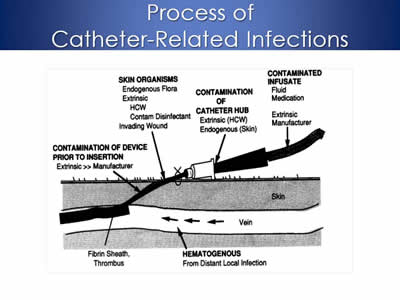
Image: Drawing of an infection site. There are five main areas from which catheter related infections can originate. Infection can occur hematogenously, from a distant local infection. Contamination of the catheter device prior to insertion, skin organisms, or contamination of the catheter hub can all cause infection. Contaminated infusate can also cause infection.
Slide 10. Five Evidence-Based Steps to Prevent CLABSI
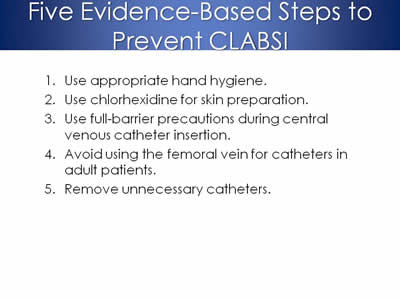
- Use appropriate hand hygiene.
- Use chlorhexidine for skin preparation.
- Use full-barrier precautions during central venous catheter insertion.
- Avoid using the femoral vein for catheters in adult patients.
- Remove unnecessary catheters.
Slide 11. Hand Hygiene
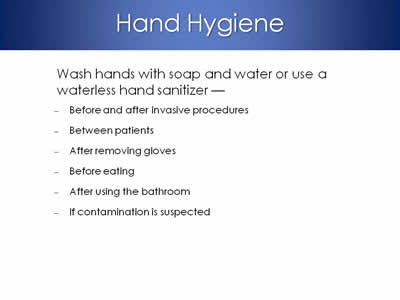
- Wash hands with soap and water or use a waterless hand sanitizer:
- Before and after invasive procedures
- Between patients
- After removing gloves
- Before eating
- After using the bathroom
- If contamination is suspected
Slide 12. Hand Hygiene Works!
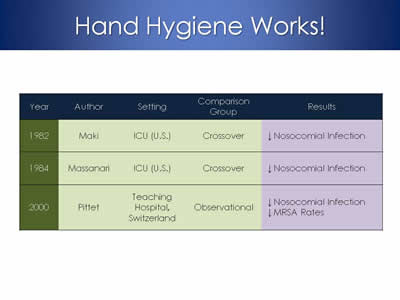
| Year | Author | Setting | Comparison Group | Results |
|---|---|---|---|---|
| 1982 | Maki | ICU (U.S.) | Crossover | ↓Nocosomial Infection |
| 1984 | Massanari | ICU (U.S.) | Crossover | ↓Nocosomial Infection |
| 2000 | Pittet | Teaching Hospital, Switzerland |
Observational | ↓Nosocomial Infection ↓MRSA Rates |
Slide 13. Waterless Hand Hygiene Steps
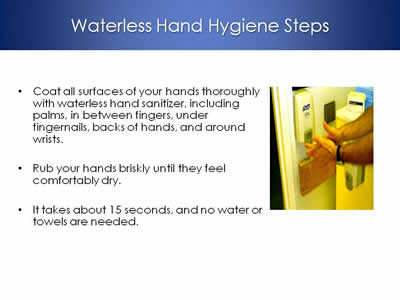
- Coat all surfaces of your hands thoroughly with waterless hand sanitizer, including palms, in between fingers, under fingernails, backs of hands, and around wrists.
- Rub your hands briskly until they feel comfortably dry.
- It takes about 15 seconds, and no water or towels are needed.
Image to the right of text: Photograph of hands using a waterless hand sanitizer.
Slide 14. Hand Washing Steps
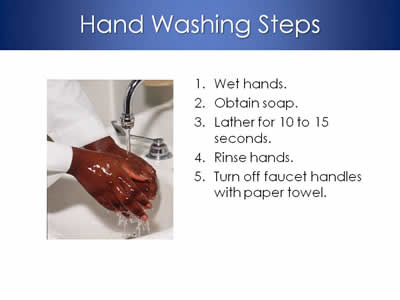
- Wet hands.
- Obtain soap.
- Lather for 10 to 15 seconds.
- Rinse hands.
- Turn off faucet handles with paper towel.
Image to the left of text: Photograph of hands washing with water under a faucet.
Slide 15. C-VAD Site Selection
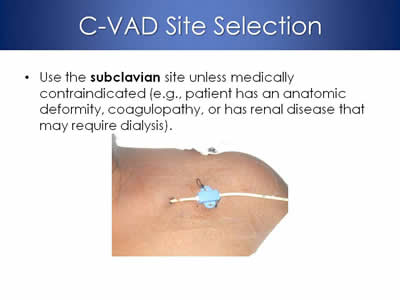
- Use the subclavian site unless medically contraindicated (e.g., patient has an anatomic deformity, coagulopathy, or has renal disease that may require dialysis).
Image: Photograph of a shoulder with a subclavian catheter inserted.
Slide 16. C-VAD Site Selection: Special Considerations
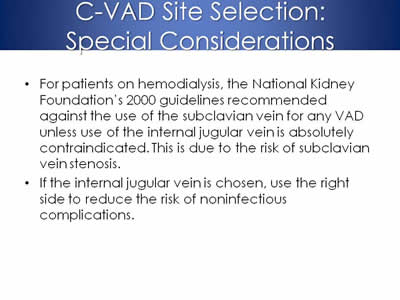
- For patients on hemodialysis, the National Kidney Foundation’s 2000 guidelines recommended against the use of the subclavian vein for any VAD unless use of the internal jugular vein is absolutely contraindicated. This is due to the risk of subclavian vein stenosis.
- If the internal jugular vein is chosen, use the right side to reduce the risk of noninfectious complications.
Slide 17. C-VAD Line Selection
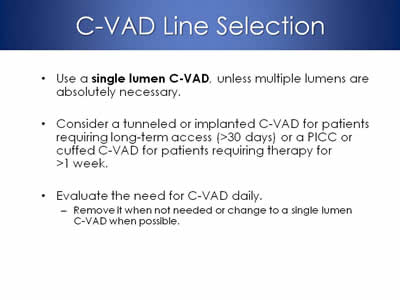
- Use a single lumen C-VAD, unless multiple lumens are absolutely necessary.
- Consider a tunneled or implanted C-VAD for patients requiring long-term access (>30 days) or a PICC or cuffed C-VAD for patients requiring therapy for >1 week.
- Evaluate the need for C-VAD daily.
- Remove it when not needed or change to a single lumen C-VAD when possible.
Slide 18. Aseptic Technique: Goals
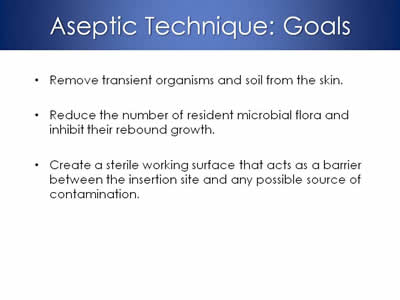
- Remove transient organisms and soil from the skin.
- Reduce the number of resident microbial flora and inhibit their rebound growth.
- Create a sterile working surface that acts as a barrier between the insertion site and any possible source of contamination.
Slide 19. Aseptic Technique
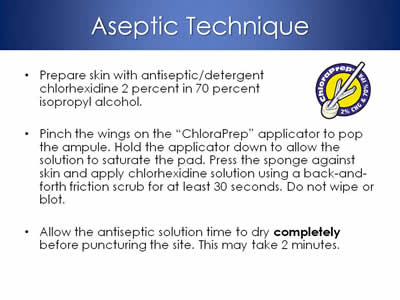
- Prepare skin with antiseptic/detergent chlorhexidine 2 percent in 70 percent isopropyl alcohol.
- Pinch the wings on the “ChloraPrep” applicator to pop the ampule. Hold the applicator down to allow the solution to saturate the pad. Press the sponge against skin and apply chlorhexidine solution using a back-and-forth friction scrub for at least 30 seconds. Do not wipe or blot.
- Allow the antiseptic solution time to dry completely before puncturing the site. This may take 2 minutes.
Image of ChloraPrep applicator.
Slide 20. Evidence Supporting Chlorhexidine Use: Skin Prep-Meta Analysis

Image of line chart comparing seven studies conducted between 1991 and 2000 that all support the use of chlorhexidine. From Ann Intern Med meta-analysis.
Slide 21. Maximal Barriers Required for C-VAD Insertion
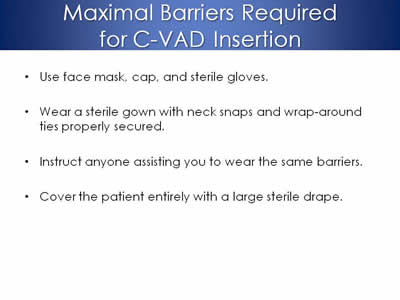
- Use face mask, cap, and sterile gloves.
- Wear a sterile gown with neck snaps and wrap-around ties properly secured.
- Instruct anyone assisting you to wear the same barriers.
- Cover the patient entirely with a large sterile drape.
Slide 22. Maximal Barrier Precautions Decrease CLABSI Infections
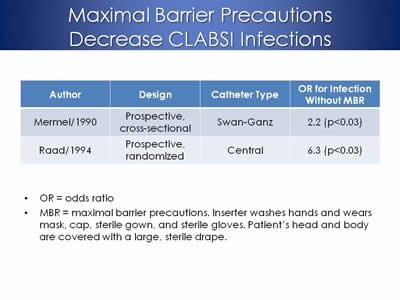
| Author | Design | Catheter Type | OR for Infection Without MBR |
|---|---|---|---|
| Mermel/1990 | Prospective, cross-sectional | Swan-Ganz | 2.2 (p<0.03) |
| Raad/1994 | Prospective, randomized | Central | 6.3 (p<0.03) |
- OR = odds ratio
- MBR = maximal barrier precautions. Inserter washes hands and wears mask, cap, sterile gown, and sterile gloves. Patient’s head and body are covered with a large, sterile drape.
Slide 23. Caveats: Catheter Insertion
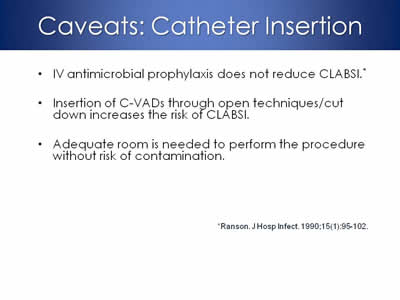
- IV antimicrobial prophylaxis does not reduce CLABSI.*
- Insertion of C-VADs through open techniques/cut down increases the risk of CLABSI.
- Adequate room is needed to perform the procedure without risk of contamination.
*Ranson. J Hosp Infect. 1990;15(1):95-102.
Slide 24. Post Insertion: C-VAD Care
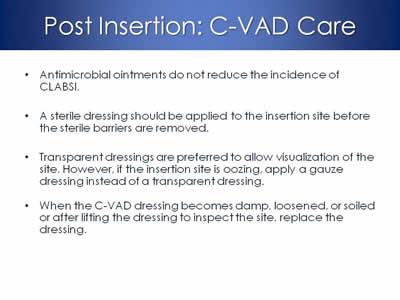
- Antimicrobial ointments do not reduce the incidence of CLABSI.
- A sterile dressing should be applied to the insertion site before the sterile barriers are removed.
- Transparent dressings are preferred to allow visualization of the site. However, if the insertion site is oozing, apply a gauze dressing instead of a transparent dressing.
- When the C-VAD dressing becomes damp, loosened, or soiled or after lifting the dressing to inspect the site, replace the dressing.
Slide 25. Replacing C-VADs
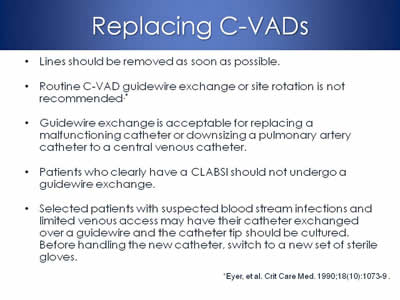
- Lines should be removed as soon as possible.
- Routine C-VAD guidewire exchange or site rotation is not recommended.*
- Guidewire exchange is acceptable for replacing a malfunctioning catheter or downsizing a pulmonary artery catheter to a central venous catheter.
- Patients who clearly have a CLABSI should not undergo a guidewire exchange.
- Selected patients with suspected blood stream infections and limited venous access may have their catheter exchanged over a guidewire and the catheter tip should be cultured. Before handling the new catheter, switch to a new set of sterile gloves.
*Eyer, et al. Crit Care Med. 1990;18(10):1073-9 .
Slide 26. Suspected C-VAD Infections
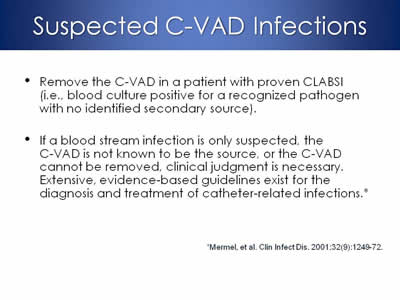
- Remove the C-VAD in a patient with proven CLABSI (i.e., blood culture positive for a recognized pathogen with no identified secondary source).
- If a blood stream infection is only suspected, the C-VAD is not known to be the source, or the C-VAD cannot be removed, clinical judgment is necessary. Extensive, evidence-based guidelines exist for the diagnosis and treatment of catheter-related infections.*
*Mermel, et al. Clin Infect Dis. 2001;32(9):1249-72.
Slide 27. Suspected C-VAD Infections (cont.)
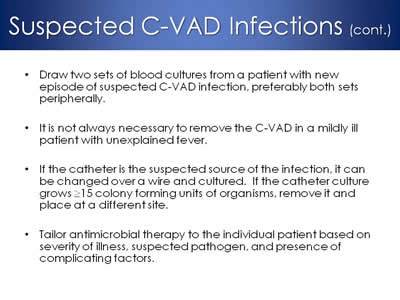
- Draw two sets of blood cultures from a patient with new episode of suspected C-VAD infection, preferably both sets peripherally.
- It is not always necessary to remove the C-VAD in a mildly ill patient with unexplained fever.
- If the catheter is the suspected source of the infection, it can be changed over a wire and cultured. If the catheter culture grows ≥15 colony forming units of organisms, remove it and place at a different site.
- Tailor antimicrobial therapy to the individual patient based on severity of illness, suspected pathogen, and presence of complicating factors.
Slide 28. C-VAD Line Cultures: Indications
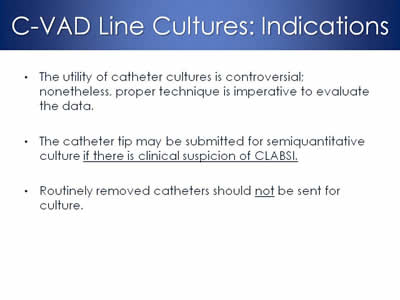
- The utility of catheter cultures is controversial; nonetheless, proper technique is imperative to evaluate the data.
- The catheter tip may be submitted for semiquantitative culture if there is clinical suspicion of CLABSI.
- Routinely removed catheters should not be sent for culture.
Slide 29. C-VAD Line Cultures: Method
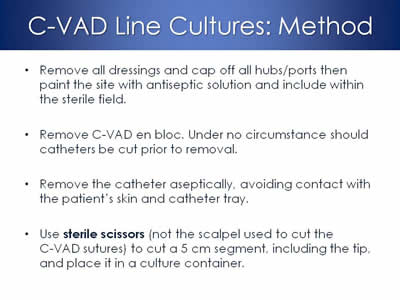
- Remove all dressings and cap off all hubs/ports then paint the site with antiseptic solution and include within the sterile field.
- Remove C-VAD en bloc. Under no circumstance should catheters be cut prior to removal.
- Remove the catheter aseptically, avoiding contact with the patient’s skin and catheter tray.
- Use sterile scissors (not the scalpel used to cut the C-VAD sutures) to cut a 5 cm segment, including the tip, and place it in a culture container.
Slide 30. C-VAD Line Cultures: Interpretation
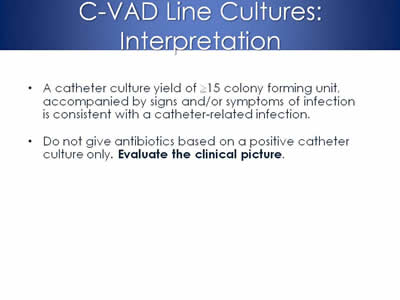
- A catheter culture yield of ≥15 colony forming unit, accompanied by signs and/or symptoms of infection is consistent with a catheter-related infection.
- Do not give antibiotics based on a positive catheter culture only. Evaluate the clinical picture.
Slide 31. Blood Cultures
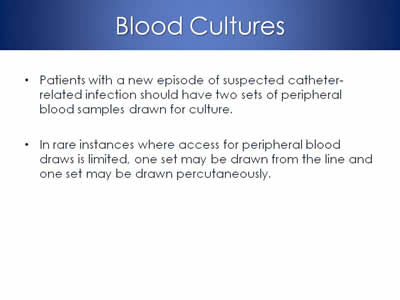
- Patients with a new episode of suspected catheter-related infection should have two sets of peripheral blood samples drawn for culture.
- In rare instances where access for peripheral blood draws is limited, one set may be drawn from the line and one set may be drawn percutaneously.
Slide 32. Peripheral Blood Cultures: Method
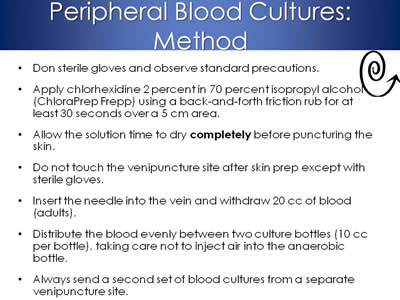
- Don sterile gloves and observe standard precautions.
- Apply chlorhexidine 2 percent in 70 percent isopropyl alcohol (ChloraPrep Frepp) using a back-and-forth friction rub for at least 30 seconds over a 5 cm area.
- Allow the solution time to dry completely before puncturing the skin.
- Do not touch the venipuncture site after skin prep except with sterile gloves.
- Insert the needle into the vein and withdraw 20 cc of blood (adults).
- Distribute the blood evenly between two culture bottles (10 cc per bottle), taking care not to inject air into the anaerobic bottle.
- Always send a second set of blood cultures from a separate venipuncture site.
Slide 33. Arterial Line: Site Selection
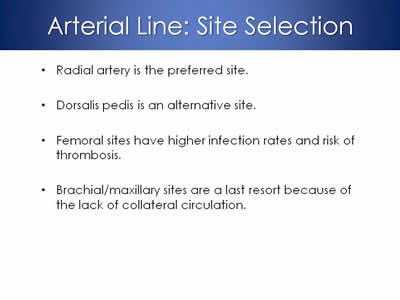
- Radial artery is the preferred site.
- Dorsalis pedis is an alternative site.
- Femoral sites have higher infection rates and risk of thrombosis.
- Brachial/maxillary sites are a last resort because of the lack of collateral circulation.
Slide 34. Arterial Lines: Aseptic Technique
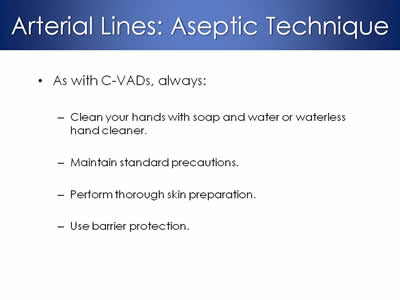
- As with C-VADs, always:
- Clean your hands with soap and water or waterless hand cleaner.
- Maintain standard precautions.
- Perform thorough skin preparation.
- Use barrier protection.
Slide 35. Arterial Lines: Barriers
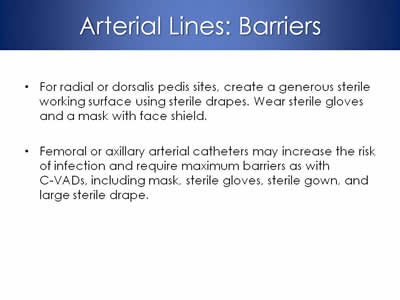
- For radial or dorsalis pedis sites, create a generous sterile working surface using sterile drapes. Wear sterile gloves and a mask with face shield.
- Femoral or axillary arterial catheters may increase the risk of infection and require maximum barriers as with C-VADs, including mask, sterile gloves, sterile gown, and large sterile drape.
Slide 36. Special Thanks

Sean Berenholtz, M.D.
Roy Brower, M.D.
Raphe Consunji, M.D.
Sara Cosgrove, M.D.
Pamela Lipsett, M.D.
Trish Perl, M.D.
Peter Pronovost, M.D.
Lisa Cooper, R.N.



